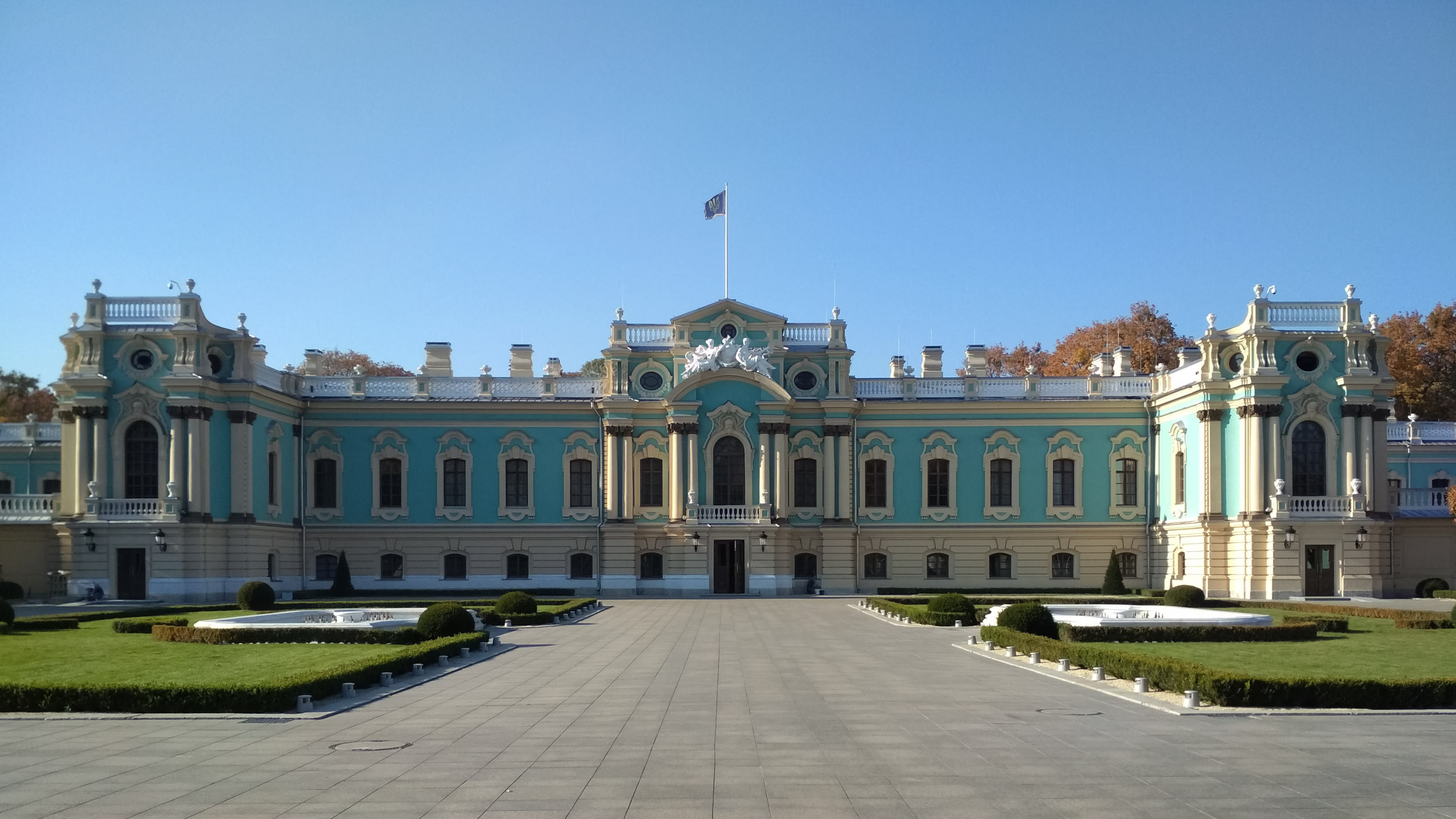 There is only one edifice in Kyiv which can answer a classical description of a palace: «a very large, richly decorated house, especially one which is, or used to be, the home of a royalty or president» (Collins Dictionary) and which dates to the «time of wide proliferation of palaces», that is, to the 18th century. The palace is called Mariyinsky. It is situated in an old part of town, called Pechersk, on top of a hill overlooking the mighty Dnipro River, surrounded by parks. There is only one edifice in Kyiv which can answer a classical description of a palace: «a very large, richly decorated house, especially one which is, or used to be, the home of a royalty or president» (Collins Dictionary) and which dates to the «time of wide proliferation of palaces», that is, to the 18th century. The palace is called Mariyinsky. It is situated in an old part of town, called Pechersk, on top of a hill overlooking the mighty Dnipro River, surrounded by parks.
In 1744 the Russian Empress Elizabeth ordered a palace built in Kyiv at a picturesque place on the hilly bank of the Dnipro River. She wanted the palace to be a close replica of Count Rozumovsky's palace at his estate of Perov not far from Moscow. Count Rozumovsky was her favourite then and his palace had been designed by B. Rastrelli, the most famous architect of the time. One of the disciples of Rastrelli, I. Michurin, was commissioned to take on the construction of the new palace in Kyiv. He, in his turn, engaged a number of other architects to help him.
The construction was completed in 1752 but the Empress Elizabeth, Peter the Great's daughter, did not live long enough to see it. The first royalty to live in the palace was Catherine II the Great (Empress, 1762-1796) who on her visit to Kyiv in 1787 stayed in it for three months. Much of the Empress' time in Kyiv was spent at magnificent balls, banquets and receptions. Later the Empress made the following entry in her diary: «Kyiv is a romantic and beautiful place.»
Originally the palace had been built of wood and brick, with parquetry on the floors, tapestry and silk on the walls and gilded stuccowork and moulding on the ceilings.
In anticipation of Catherine's visit it was furnished with pieces of rich furniture and adorned with works of art. In the late 18th and early 19th centuries the palace was a residence of Governor-Generals. In 1812 the right wing of the palace burned down and in 1819 another bad fire did further damage to the palace: the second floor, made basically of wood, was reduced to ashes. It was only in 1834 that reconstruction work was begun. The Kyiv Artificial Mineral Water hydropathic Company renovated the building and turned it into a (hydropathy — treating diseases.
In 1868 the Czar Alexander II issued an order to restore the palace to its former splendour. Architect Mayevsky, who was commissioned to do the work of reconstruction, did a good job of preserving the basic features and general appearance of the original palace and almost completely changing the interior. Mariya Alexandrovna, the wife of the Czar, donated a very considerable sum of her own money to the reconstruction project. She wanted a big park to be laid out on the southern side of the palace; the empty space there had previously been used as a parade ground. The new park, to honour the Empress, was called «Mariyinsky» and later the palace itself came to be referred to as «Mariyinsky» as well.
In the stormy years of the 1917 Revolution and Civil War the palace was used as a military headquarters. In the twenties an agricultural school was housed there, later the palace was turned into a museum. In the Second World War the Mariyinsky was badly damaged and restored at the end of the forties. In the early eighties a major restoration was undertaken. Now the palace is used for official receptions and as a venue for summits.
The central hall of the palace is called «Bily» («White») or «Baletny» («Hall for Balls»). High official receptions are held in this hall; ambassadors receive their accreditation, most important documents and agreements are signed. Another of the stately halls, known as the Green Reception Room, is often used for conducting talks with foreign delegations and state leaders. The Green Reception Room has seen US Presidents Nixon, Bush and Clinton, British Premier Thatcher, French President Mitterand and German Chancellor Kohl.
There are 26 rooms on the second floor, most of them richly adorned suites and halls. There are many fireplaces and even in the severest of winters they could keep the place cosily warm but for safety reasons central-heating radiators are used. The walls are hung with paintings borrowed from picture galleries of Kyiv, L’viv and Odesa. They are works both by foreign and Ukrainian artists.
55 rooms of the ground floor are used by security, press and other services. There are rooms for physicians and rooms for performing artists to change in before their performances which are organized in the palace on some special occasions.
The Mariyinsky Palace is an elegant architectural landmark. So successfully are the various sections of the palace linked and blended that it is difficult to dissociate them and study singly. It is a harmonious blend of several styles. The delicacy of the outlines and the restrained decorations of the facades are skilfully attuned to the idyllic settings afforded by the park.
By Alex Pan
|